The Rosewill Photon 1050W Review
by E. Fylladitakis on March 24, 2015 8:00 AM EST- Posted in
- Cases/Cooling/PSUs
- Rosewill
- 1050W
- Sirfa
Hot Test Results
By the results presented in the following tables, the Rosewill Photon 1050W offers good power quality, especially considering the temperatures that the components reached inside our hotbox. The maximum ripple on the 12V line was 56mV under full load, a fair figure considering that this is a unit rated for operation at 40°C. The 3.3V/5V voltage lines fared better, with the maximum ripple being 22mV/24mV respectively. Voltage regulation is very good, at just 1.2% for the 12V line and about 1.6% for the minor lines.
| Main Output | ||||||||
| Load (Watts) | 212.08 W | 528.3 W | 788.6 W | 1047.54 W | ||||
| Load (Percent) | 20.2% | 50.31% | 75.1% | 99.77% | ||||
| Line | Amperes | Volts | Amperes | Volts | Amperes | Volts | Amperes | Volts |
| 3.3 V | 4.17 | 3.37 | 10.44 | 3.35 | 15.66 | 3.33 | 20.87 | 3.31 |
| 5 V | 4.17 | 5.13 | 10.44 | 5.09 | 15.66 | 5.07 | 20.87 | 5.05 |
| 12 V | 14.61 | 12.09 | 36.53 | 12.05 | 54.8 | 11.99 | 73.06 | 11.95 |
| Line | Regulation (20% to 100% load) |
Voltage Ripple (mV) | |||||
| 20% Load | 50% Load | 75% Load | 100% Load | CL1 12V |
CL2 3.3V + 5V |
||
| 3.3V | 1.6% | 8 | 12 | 18 | 22 | 12 | 26 |
| 5V | 1.55% | 10 | 16 | 22 | 24 | 16 | 26 |
| 12V | 1.2% | 20 | 32 | 44 | 56 | 54 | 20 |
Once again, we need to mention that this is a PSU rated at 40°C and we perform our testing at temperatures higher than 45°C - we could reduce the ambient temperature of our hotbox testing but we chose not to do so as the results would then not be comparable to those of our previous reviews.
The high ambient temperatures have a significant impact on the electrical performance of the Photon 1050W, reducing its energy conversion efficiency by an average of 2%. The drop is higher as the load increases, reaching a massive 3.7% drop with a load of 1050W. Considering that the ambient temperature is almost 48°C at this point, these actually are overload conditions for the Photon, meaning that its capability to maintain good power quality and keep operating with such a load is a victory all by itself.
By looking at the internal temperatures of the Photon 1050W, one can easily realize who the culprit behind the dropping efficiency is. This is one of the hottest PSUs we have ever tested. With the temperature of the secondary side heatsink surpassing 100°C under maximum load and the primary side heatsink following closely, it is easy for anyone with basic electronics knowledge to deduct that the exceedingly high temperatures at the very least increase the resistance of the components. The cooling fan is now audible even at low loads, with its speed constantly increasing to keep up with the increasing energy losses. Even though it jumps at maximum speed when the load is about 900 Watts, it cannot stay ahead of the curve with the heavy energy losses.


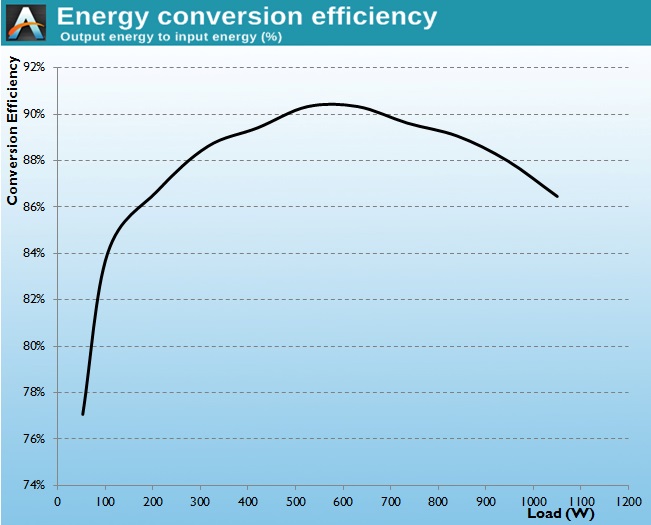
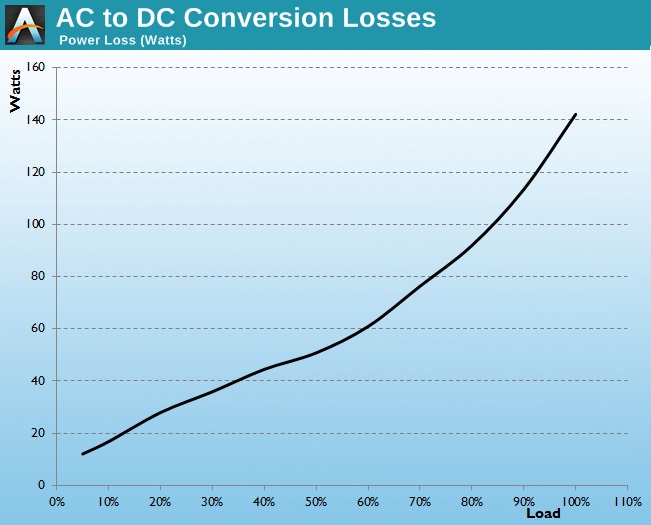
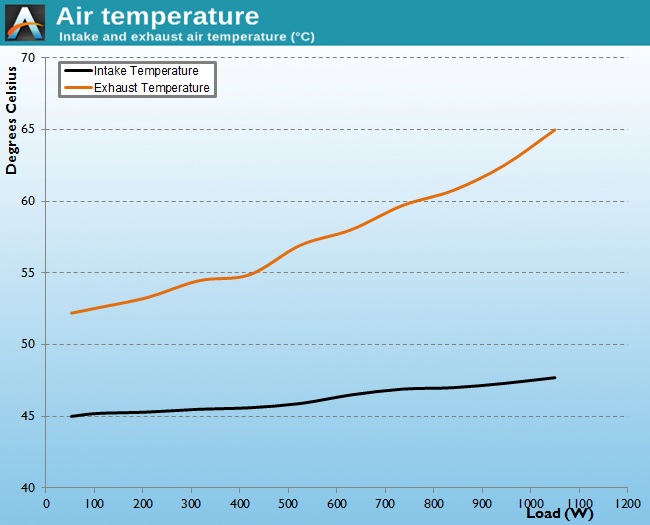
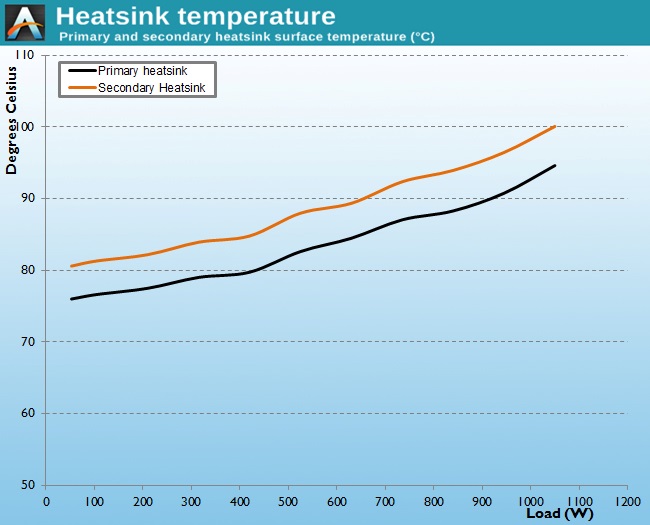
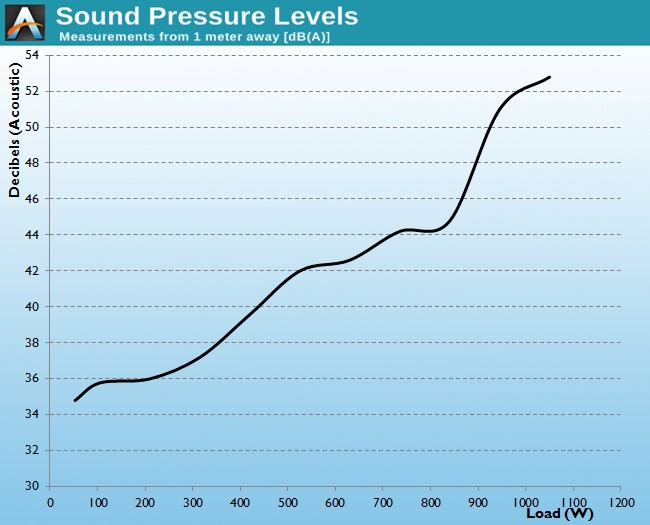








42 Comments
View All Comments
etamin - Tuesday, March 24, 2015 - link
I'm still waiting for a high quality PSU that is:300-550W
80 Plus Gold/Plat
fully modular
active cooling (preferrably a hybrid fan)
available as SFX
I would imagine it is easy for a company like Seasonic to put out such a device. If only their lower wattage Plat models had some sort of active cooling, I would be less reluctant to buy one.
phantomferrari - Wednesday, March 25, 2015 - link
You mean like these :)http://silverstonetek.com/product_power.php?tno=7&...
Jahzah_1 - Wednesday, March 25, 2015 - link
Personally, I have always gone the opposite route. The power supply is the most underrated and unappreciated component in PC building. The first reason is upgrade path. you never know if you will add other components later. As an avid AMD user, they have stuck with one socket for awhile, so having a beefier PS unit that can handle a dramatic change in TDP (with overclocking) pays dividends.The second and most important reason is the strain on the PSU itself. My rule of thumb is to try and stay under half of the rated watts of the unit. Though truth be told, the Amperage is the more important feature to account for. If i calculate my power needs to be no more than 400 watts @ 30 to 40 amps, I will always go for a min of 800 watts @ 60-80 amps. the reason is again strain. Just my personal preference. I use the car comparison the most for people building for the first time. If my car can go 150 MPH, i can't expect to maximize longevity by going that fast continuously. but at 75 MPH all parts of the car can handle that for much longer.
SirGCal - Tuesday, March 24, 2015 - link
There's more to power supplies then raw numbers. Actually I want to see how smooth and accurate the power is myself. Having more power then you need isn't bad, just cost money. Power supplies also lose power over time as they age but it takes quite a bit to make any real notice. Still, I like to keep them running well under their power band for both heat and noise. There are plenty of 500-1kW units out there that fit the budget lineup. I'm running an SLI setup now with a 750W unit and still have plenty of headroom.But what I am interested in is the power clarity and accuracy, especially in these gold and higher rated units. And unfortunately, the extremely low power supplies tend to be the cheapest, noisiest (signals), and more inaccurate units. Since power is the core of any system, stable and accurate power is paramount to a good and stable system. It's one area that I refuse to skimp on in any build. But still don't go insane at the same time. But I'd easily spend $100 for a solid, accurate, tested unit instead of a $40 Joe's Power Supply version...
chlamchowder - Tuesday, March 24, 2015 - link
What I'd like to see is how that $40 supply compares to a $100 supply - and that would include power delivery characteristics. If Anandtech would test some of those cheaper units, maybe we'll find that spending $100 on a 500W power supply is really unnecessary.Also, note that a mildly overclocked i7-4790K with a GTX 980 fits comfortably within a 500W power envelope.
kmmatney - Tuesday, March 24, 2015 - link
Between my wife and 3 kids, and my work computers (I work at home) I have 10 desktop machines at home, all fast and all used for gaming or running virtual machines or both. Most system are overclocked, and have hungry video cards. My system has a Corsair 650W system I bought 8 years ago, but most of the other systems have more modest PSUs, most of which I bought on sale for ~$40 (typically Antec Earthwatts or Rosewill 500W units). I've never had any stability problems with any of them. My server has a 500W PowerMan PSU with 6 hard drives, 2 SSDs, and a devil's Canyon i5 overclocked to 4.5 Ghz (can go higher) - this PSU came free with an InWin case I bought 5 years ago. If you have a single computer, then it makes sense to pay $90-120 on a good power supply, but when you have 10 computers to pay for, you'll find $40 (on sale) PSUs can work just fine. The motherboard already has plenty of power circuitry on it to deal with ripple, etc... I have the $45 Rosewill 450W PSU powering a hex-core OC AMD cpu + OC 560Ti video card on one system, and an overclocked G3258 + HD6850 on another system.KAlmquist - Tuesday, March 24, 2015 - link
The Seasonic SSR-360GP is by all accounts a quality PSU, and costs $60, so you don't have to spend $100 to get quality unless you need higher wattage. People who want modular cables could go with the SSR-450RM ($80), which is probably equal in quality, although I haven't purchased it and therefore didn't read the reviews carefully. Neither of these products were reviewed by Anandtech. In fact, I've never consulted an Anandtech review when buying a PSU.E.Fyll - Tuesday, March 24, 2015 - link
Well, the primary reason is that the manufacturers generally like to showcase the best they have. One company representative argued, and I partially agree, that "Someone who goes and buys a $30 PSU will not bother to check the reviews to begin with. If they are to spend >$100, they both know what they want and will check it out thoroughly before placing an order.". The other half, I will add it myself - manufacturers like to show the best they have because it reflects on their brand as a whole. If a 1.5kW PSU aces the tests, some people would (erroneously) think that their $30 unit is just as good.I do agree that the common home PC does not require more than a 500W PSU, tops. The problem is that there are actually very very very few such PSUs coming from any reputable manufacturer and even those are very basic units, based on designs and platforms that may be a decade old. There is nothing really interesting about them and the users will not actually care (although they should) if, for example, the maximum ripple is 80mV instead of 40mV.
I do try to source "small" PSUs when possible - hence the reviews of the Antec Edge 550W, the Nightjar NJ520, the Dark Power Pro 10 650W. It's not even half of the units I reviewed, I know, but it is not always possible to source small units, neither I can write a dozen PSU reviews per month.
chlamchowder - Tuesday, March 24, 2015 - link
I disagree that people going for budget PSUs won't bother to read reviews. I for one tried, until I realized such reviews were nonexistent. If someone's going so far as to pick individual parts for a computer, there's a good chance they'll care about a component as important as the PSU.Even if you don't find them interesting enough to write a review on, making some test data available would be very useful.
chlamchowder - Tuesday, March 24, 2015 - link
Also, like another poster said, there's more of a risk factor with low priced PSUs. That makes reviews (or even just raw data) even more critical.It'd be crazy to ask for 12 PSU reviews a month, but it'd be awesome if a PSU with a popular internal design gets tested, and models using the same design are just listed.
Finally, if a PSU does fail (http://www.bit-tech.net/hardware/psus/2014/06/20/5... that'd be very, very good to know.